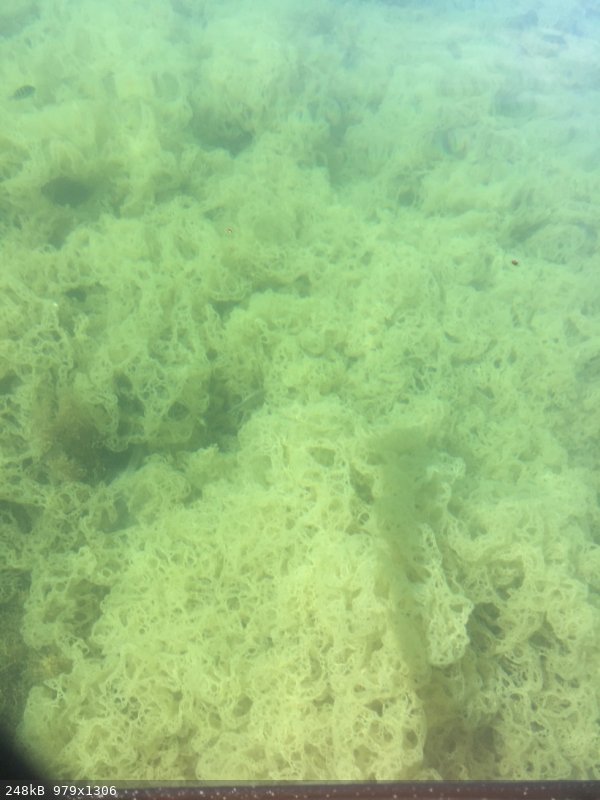
ChuckB - 4-8-2022 at 01:48 PM
We were camped at Playa Coyote March 20-21 and again 25-29 and went kayaking around Coyote bay. We were surprised by the new (to us anyway) specie of
seaweed in many shallow areas. It is yellowish (and maybe a bit greenish) and looks like lace.
Attached is a picture of that seaweed in water 3-5 feet deep.
We also noted many fewer small reef fish in places where we had seen them over the years.
While kayaking near Playa Escondido I passed a kayaker with fishing gear who said the seaweed just showed up in recent weeks and that he caught
nothing in his favored spot for trigger fish.
I you have a clue as to what is going on, I'd be keen to hear.

BigWooo - 4-9-2022 at 04:56 AM
Don't know what it's called but common in the spring time. Remember seeing it as far back as 30 years ago kayaking that area.
ChuckB - 4-15-2022 at 04:22 PM
Thanks for the clarification, BigWooo.
Glad to hear its `normal' and not something new and awful.
gnukid - 4-15-2022 at 07:27 PM
Looks like it could be Yellow Sponge Seaweed Hydroclathrus clathratus.
ChuckB - 4-16-2022 at 09:46 AM
Thanks, gnukid.
Looking at the Wikipedia page for Hydroclathrus, there is a picture of Hydroclathrus clathratus that looks just like what we were seeing. Always
something new to learn.
Vince - 4-16-2022 at 04:48 PM
I also have seen that seaweed for many years. It will clear up as well as the other types that float in from deeper water. I just returned from
Coyote Bay and the trolling of Rapalas and other lures had its usual problems with dragging seaweed.
BajaTed - 4-18-2022 at 11:54 AM
Seaweed (Kelp) is a producer, it uses nutrients from the the water and sun to make its own food.
Nutrients might be the seasonal change and maybe the sun to a degree cuz its always sunny in Baja, especially in Bahia Concepcion with its steady
state environment impervious to climate change. 

wilderone - 5-1-2022 at 07:51 AM
Interesting - eat up!
Hydroclathrus is commonly used for human consumption in the form of salads; agriculture application such as animal feeds and fertilizer
A variety of natural products are found in the genus Hydroclathrus similar with other brown seaweeds. These are: Fatty Acids; Minerals: cadmium (Cd),
copper (Cu), mercury (Hg), Iodine (I), nitrogen (N), nickel (Ni), lead (Pb), and zinc (Zn). Phytohormones: auxin, cytokinin, and gibberellin;
Pigments: carotene, chlorophyll a, chlorophyll c, fucoxanthin; Polysaccharides/ simple sugars: alginic acid, fucoidan, and laminarin; Protein; Sugar
Alcohol: mannitol; Vitamins: folic and folinic acid. [8]
For medicinal application, antiviral polysaccharides were extracted from Hydroclathrus clathratus. These are H3-a1 and H3-b1. In addition, the
extracts' derivatives were observed to have anticoagulant properties.[9] Furthermore, Hydroclathrus polysaccharide, H3-a1, was observed to have
antitumor potential. It suppresses scitic Sarcoma 180 tumor growth and prolonged the life span of mice in laboratory experiments by inducing increased
tumor necrosis factor-alpha (TNF-α) level in mouse serum. However, further studies is needed to determine its effectiveness for as a medicinal
product. [10] Other potential medicinal use for Hydroclathrus, is its antimicrobial property observed in-vitro settings. [11]
Potential for application for environment utilization, particularly for solid waste management for wastewater treatment were also explored. The
residue powder of Hydroclathrus clathratus after being extracted most of its active components in methanol were used as absorbent material for
wastewater treatment from excess heavy metals such as cadmium (Cd) and copper (Cu). This provided new insights on the potentiality use of seaweed as a
treatment tool for wastewater and develop efforts in resource managemen


